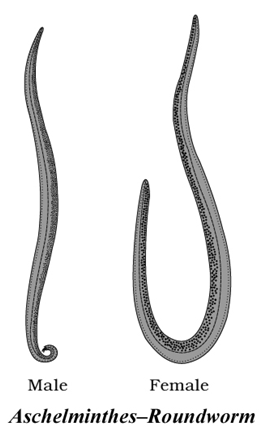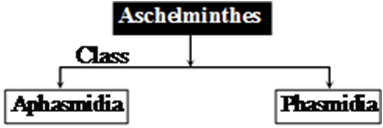- Books Name
- ACME SMART COACHING Biology Book
- Publication
- ACME SMART PUBLICATION
- Course
- CBSE Class 11
- Subject
- Biology
PHYLUM: NEMATHELMINTHES OR ASCHELMINTHES

The phylum includes bilaterally symmetrical, triploblastic, pseudocoelomate animals with organ system grade of organisation. They are circular in cross-section.
They are free living, aquatic or terrestrial or parasitic (on plants or animals).
Excretory system involves an excretory cell (a large giant H-shaped cell) called Renette cell (multinucleated).
They have tube-within tube type of body plan evolved along Protostomic evolutionary line.
Sexes separate, show sexual dimorphism, fertilisation internal, development direct or indirect.
CLASSIFICATION
On the basis of caudal receptor or phasmids, Aschelminthes can be divided into 2 classes-


Important classes of this phylum are:
Class : Nematoda.
Examples: Ascaris, Wuchereria, Enterobius, Trichuris. Rhabditis is a free living roundworm.
Class : Rotifera.
Examples: Wheel worms
Phylum Aschelminthes
Roundworms are the popular name for Aschelminthes. They are triploblastic, bilaterally symmetrical, and pseudocoelomates creatures. Aschelminthes can be parasitic or free-living. The free-living creatures, which feed on bacteria, are abundant in soils and sediments. Others are plant parasites that can cause disease in economically significant crops. The remaining parasites can be found in both animals and humans. Hookworms, pinworms (Enterobius), Guinea worms (Dracunculus), and intestinal roundworms are examples of parasitic worms. A well-developed muscular pharynx completes the alimentary canal. Through the excretory hole, an excretory tube transfers body wastes from the body cavity. In most of the Aschelminthes, the respiratory and circulatory systems are absent. They utilize the process of diffusion for the circulation of oxygen. Aschelminthes are dioecious, which means they are separate. Females are frequently taller than males.Internal fertilization occurs, and development can be either direct (the young resemble the adult) or indirect. The Giant Intestinal Roundworm (Ascaris lumbricoides) is an endoparasite that lives in the human gut. They're quite prevalent in kids. Ascariasis is a disease caused by these worms. Many adult roundworms dwell inside the intestine, obstructing the digestive tract.Examples: Ascaris (Roundworm), Wuchereria (Filaria worm), Ancylostoma (Hookworm).


 ACME SMART PUBLICATION
ACME SMART PUBLICATION
